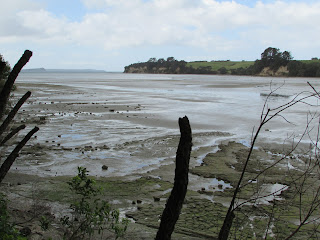We stopped to show them all our usual landmarks like the "Adversity Tree" with the roots navigating around a giant stone and the"Circle Tree" that always reminds us that when we find ourselves going in the wrong direction we can TURN AROUND.
We have brought others here before, and everyone has enjoyed it. However each time we have visited in the past we always stopped when we got to the first major set of stairs.
 |
| There are a whole other set beyond what shows up in this picture. We did not count them, but there are A LOT of stairs! |
We knew that if we went down all those steps, we'd have to climb up them again on the way out. Since there was so much beauty in the first section of the hike, we were satisfied only experiencing that part.
This time however, we decided to walk all the way to the cottage. The Streeters are pretty serious hikers and they were up for the challenge. It was a gorgeous day. Why not? So on we went. We were not disappointed. We saw so much more on the next section - from the bridge over the creek where there was a sweet little waterfall all the way down to the beach.

We had fun all taking turns on the rope swing by the Dacre Cottage and loved soaking in all the lush beauty of the place.

Here is a little history about Dacre Cottage:
This little brick building was erected originally about 1855 on a block of 3334 acres purchased in 1848 by Ranulph Dacre, an"adventurer merchant" who operated trading vessels between Sydney and New Zealand carrying livestock, produce and timber. The land formed part of a 20,000 acre Weiti block originally sold to Henry Taylor by Maori chiefs of the Ngati Whatua; Ngati Poa; and Ngati te Matua tribes.
By 1842 when the land claim had been verified, Henry Taylor had sold more than half of the block to H.B. Sparke of Sydney. Captain Dacre purchased the land from Sparke but did not settle on the land. Dacre's sons, Henry and Septimus, farmed the block as a cattle station. The cottage was constructed of bricks that were believed to have been used as ballast in Dacre's sailing vessel,s and originally had a shingle roof which was later replaced by corrugated iron. The Dacre family farmhouse was built nearby, (south of where the large Norfolk Pine now stands), and the little brick building was used as an abattoir when the family moved into their farmhouse.
After some play and rest it was time to head back UP the hill, retracing our path up all those many stairs. By the time we got back to the car Stephen's phone said we had hiked 11.79 kilometers (a little over seven miles), and had climbed a whopping 80 flights of stairs. By the time we were done my knees and feet were weary and sore, but it was so very worth it!
When we got home we took a break for some rest and a shower. Then we headed over to the Streeter's apartment to have dinner together. We had to keep reminding ourselves that we had only just met them a couple weeks before when they arrived. We all got along famously as if we were dear old friends.
Truly, one of the sweetest blessings of this mission has been the special friendships we have made along the way. These are people we hope to stay close with for many years to come.



















No comments:
Post a Comment